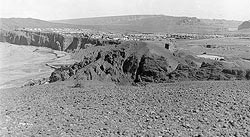1st Queen's in the Arakan
The Battle of the Boxes
 |
| C Coy 1st Bn The Queen’s Royal Regiment on way to Razmak, North West Frontier 1941. Cpl Bennet, Pte’s Sawyer, Harris, West. (Click to enlarge) |
The area of operations lay between the port of Akyab to the south and Cox’s Bazaar in the north in what has become Bangladesh. By the time 1st Queen’s arrived there the Japanese occupation of Burma extended from the Arakan north-eastwards for hundreds of miles along the mountains which bordered on India and included the vital Burma Road link with China from Lashio to Chungking. The Japanese tactics as they advanced from Rangoon had been those which they had used so successfully in Malaya against opposition which they greatly outnumbered and which lacked air support. They repeatedly bypassed the defensive positions they encountered on the main route north by moving through dense hill jungle which the British regarded as impenetrable and established themselves in their rear, keeping up an impetus of constant assault.
The Queen’s first operational task was the defence of the Teknaf peninsula which stretches south for some thirty miles between the River Naf and the sea, and which at its southern limit overlapped the Japanese base at Maungdaw on the mainland side. Extensive patrolling revealed that the peninsula was no longer occupied by the enemy. Contact was made when ‘B’ Company, commanded by Captain M.A. Lowry, made a hazardous night crossing of the river in sampans in a diversionary raid against Maungdaw in support of an advance by another brigade in the hills to the east of the town.
(Click to enlarge) |
 A
major offensive involving the 5th and 7th Indian Division began
as the monsoon weather eased. The objective was to take the one
all-weather road held by the Japanese which ran eastwards from
Maungdaw to Buthidaung and was the Japanese main supply route
from the interior, and to clear the mouth of the River Naf which
would enable British supplies to be brought in by sea. 1st Queen’s
were involved in a number of operations mainly involving company
attacks through difficult country, one particularly swampy valley
being referred to as Wet Valley.
A
major offensive involving the 5th and 7th Indian Division began
as the monsoon weather eased. The objective was to take the one
all-weather road held by the Japanese which ran eastwards from
Maungdaw to Buthidaung and was the Japanese main supply route
from the interior, and to clear the mouth of the River Naf which
would enable British supplies to be brought in by sea. 1st Queen’s
were involved in a number of operations mainly involving company
attacks through difficult country, one particularly swampy valley
being referred to as Wet Valley.
Much was required, and was forthcoming, of individual skill, initiative and determination. Casualties were sustained, many Japanese were killed and, notably, two prisoners were taken. POWs were greatly sought after for intelligence purposes but this was an enemy who regarded capture as dishonourable and would take their own lives, and preferably those of their opponents as well, to avoid it. Taking prisoners was difficult and dangerous.
 |
| 1st Bn The Queen’s Royal Regiment, Razmak on the North West Frontier, 1941. (Click to enlarge) |
By the end of January 1944 Maungdaw had been occupied and the road west of it was cut. However in February it appeared that the Japanese had penetrated behind the two Divisions and were preparing to counter-attack in force with the aim of overrunning 7th Division and then pushing back 5th Division onto the River Naf. The Japanese attack had been anticipated. Units were ordered to hold their ground and form defensive boxes, local air superiority was established, and air supply began. ‘C’ Company had to be sent to rescue a mortar battery and then fought its way to the 7th Division headquarters box which became known as the Admin Box. ‘A’ Company was detached to become brigade reserve. The remainder of the Battalion formed the Braganza Box.
 The
enemy failed to overrun any of the 7th Division boxes. As counter-attacks
by other formations developed the Japanese attempted to disengage
to the south and 1st Queen’s fighting patrols were constantly
deployed to harass them. The policy of standing firm and the availability
of air support had been well justified. British casualties were
light, Japanese were heavy.
The
enemy failed to overrun any of the 7th Division boxes. As counter-attacks
by other formations developed the Japanese attempted to disengage
to the south and 1st Queen’s fighting patrols were constantly
deployed to harass them. The policy of standing firm and the availability
of air support had been well justified. British casualties were
light, Japanese were heavy.
 |
| (Click to enlarge) |
1st Queen’s then moved to take part in operations south of the Maungdaw-Buthidaung road in order to follow up the Japanese and attack before they had time to reorganise. By 14th March Buthidaung had been captured but difficult and dangerous patrols continued in the adjoining Massif area where parties of Japanese still remained. On 25th March the battalion moved back to help forestall a Japanese counter-attack against the Admin Box. The Japanese were unable to sustain their renewed offensive and were gradually killed or driven out. During the first weeks of March the Japanese main offensive began on the central front and began to threaten Imphal and Kohima. On 3rd April 1st Queen’s marched out from the Admin Box, the first time they had been out of direct contact with the enemy in four months, and moved to Chittagong to emplane for Assam.
Related

